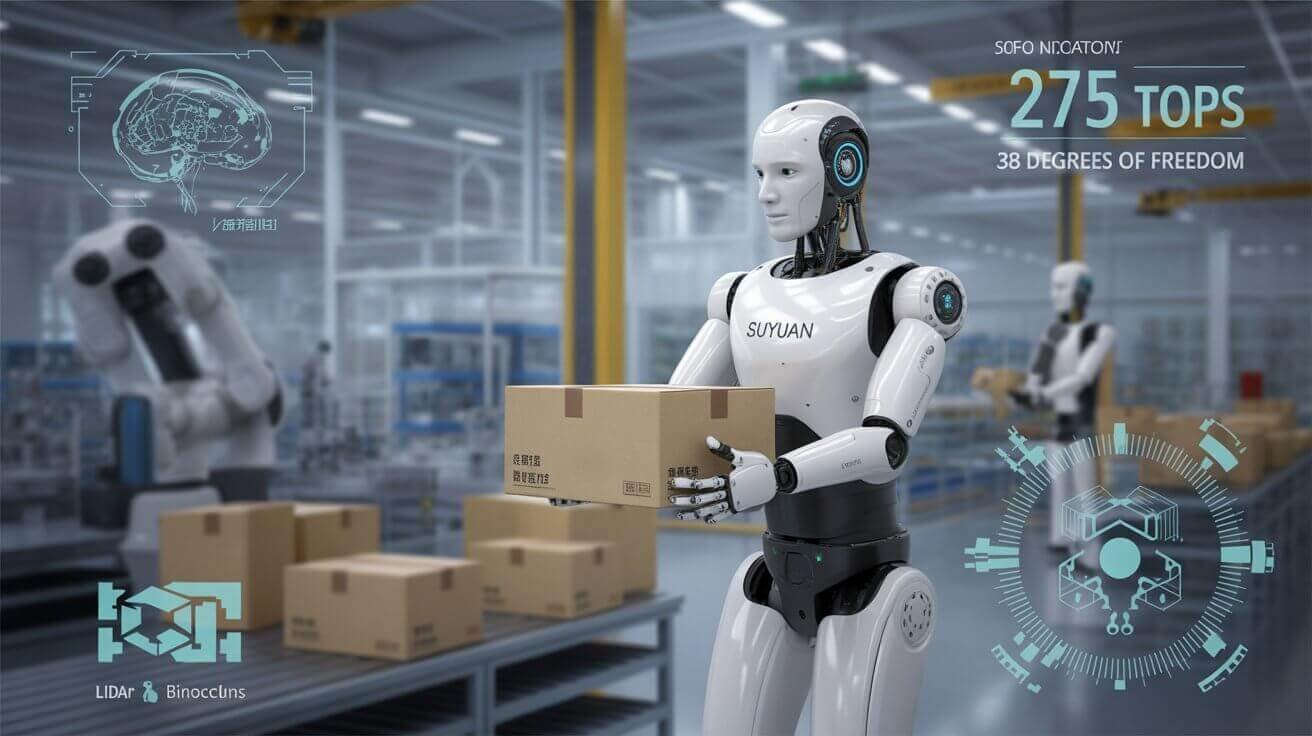I’ve been following robotics for years, but what I saw at Shanghai’s World Artificial Intelligence Conference last month genuinely surprised me. China humanoid robot manufacturing has reached a tipping point that most people haven’t fully grasped yet. Shanghai Electric just unveiled SUYUAN, a humanoid robot with a brain capable of 275 trillion operations per second—and it’s not just impressive tech, it’s a preview of how work itself is about to change.
Moreover, China humanoid robot manufacturing represents more than technological advancement. It signals a fundamental shift in global manufacturing that could affect everything from factory jobs to international trade dynamics.
What Makes SUYUAN Different from Other Industrial Robots
SUYUAN isn’t your typical factory robot arm bolted to the floor. Standing 167 cm tall and weighing 50 kg, this humanoid robot moves through warehouses and production lines like a tireless human worker. However, its 38 degrees of freedom and 275 TOPS of processing power give it capabilities that surpass human limitations.
The robot can carry up to 10 kg total and lift 2 kg with a single arm while moving at 5 km/h. Additionally, its combination of LiDAR and binocular vision allows autonomous navigation through complex industrial environments. During demonstrations, SUYUAN successfully identified, picked up, and relocated boxes of various sizes using advanced computer vision.
But here’s what impressed me most: the robot understands commands in natural language thanks to integration with large language models. Instead of requiring complex programming, workers can simply tell SUYUAN what they need done, and the robot figures out how to accomplish the task.
The Technology Behind the Revolution
The 275 TOPS AI processor represents a significant leap in on-device computing power for robotics. Furthermore, this processing capability enables real-time decision making without relying on cloud connectivity. Consequently, SUYUAN can adapt to changing conditions instantly, making it suitable for dynamic manufacturing environments.
Shanghai Electric didn’t develop this technology overnight. The company holds 189 patent applications in humanoid robotics, with 120 already granted. This extensive intellectual property portfolio demonstrates their commitment to China humanoid robot manufacturing leadership.
Real-World Applications Across Industries
Manufacturing and Assembly Lines
In manufacturing settings, China humanoid robot manufacturing solutions like SUYUAN excel at repetitive, precision tasks. The robot’s 38 degrees of freedom allow both wide-range motions and delicate manipulations, making it suitable for assembly work that previously required human dexterity.
Manufacturing companies report that humanoid robots can work continuously without fatigue, breaks, or shift changes. Additionally, they don’t require ergonomic considerations or safety equipment that human workers need. This combination dramatically increases potential productivity while reducing operational costs.
Logistics and Warehousing
Warehouses present ideal environments for China humanoid robot manufacturing applications. SUYUAN’s ability to navigate autonomously while handling objects of varying sizes addresses key logistics challenges. The robot can work alongside human employees or operate independently during off-peak hours.
Morgan Stanley projects the humanoid robot market will reach $5 trillion by 2050, with logistics representing a significant portion of this market. Companies adopting these technologies early may gain substantial competitive advantages.
Healthcare and Elder Care
Beyond industrial applications, China humanoid robot manufacturing extends into service sectors. Humanoid robots can assist with patient care, medication delivery, and routine monitoring tasks. Their human-like appearance helps patients feel more comfortable compared to traditional medical equipment.
Given China’s aging population, the government sees humanoid robots as essential for addressing labor shortages in healthcare. This demographic pressure drives significant investment in China humanoid robot manufacturing capabilities.
Economic and Strategic Implications
China’s Manufacturing Advantage
China currently dominates 63% of the global humanoid robot supply chain, particularly in hardware components like actuators, sensors, and lithium-ion batteries. Consequently, even American and European robot manufacturers depend on Chinese suppliers for essential parts.
Beijing announced it would invest 1 trillion yuan ($138 billion) in robotics and high tech over the next two decades, far exceeding investments by the US or Europe. This massive funding supports China humanoid robot manufacturing from research through mass production.
Labor Market Transformation
The implications for workers deserve serious consideration. While robots eliminate some jobs, they also create new roles in robot maintenance, programming, and supervision. However, the transition period may prove challenging for workers in affected industries.
China’s working-age population is expected to shrink by 22% through 2050, according to the Lowy Institute. Therefore, humanoid robots aren’t just replacing human workers—they’re filling gaps that demographic changes would otherwise leave unfilled.
Global Competition Dynamics
American companies like Tesla, Figure AI, and Boston Dynamics are racing to compete with China humanoid robot manufacturing. Tesla aims to produce 5,000 Optimus robots this year, while Shanghai-based Agibot plans similar production numbers.
Nevertheless, China’s manufacturing cost advantages may prove decisive. Chinese robots are roughly 80% as capable as industry leaders but cost 30% less, creating compelling value propositions for many applications.
Practical Steps for Businesses and Workers
For Business Leaders
Companies should start evaluating how China humanoid robot manufacturing solutions might affect their operations. Begin by identifying repetitive, dangerous, or labor-intensive tasks that robots could potentially handle.
Consider pilot programs with existing humanoid robot providers before committing to large-scale deployments. Additionally, invest in worker training programs to help employees transition to robot-collaborative roles.
For Workers and Job Seekers
Focus on developing skills that complement rather than compete with robot capabilities. These include creative problem-solving, complex communication, and tasks requiring emotional intelligence.
Furthermore, consider training in robot maintenance, programming, or supervision. As China humanoid robot manufacturing scales up, demand for these specialized skills will increase significantly.
For Investors
The humanoid robotics sector presents both opportunities and risks. While the technology shows enormous promise, the market remains early-stage with uncertain timelines for widespread adoption.
Moreover, geopolitical tensions could affect international access to China humanoid robot manufacturing technologies. Diversified investments across multiple regions and companies may prove wise.
Looking Ahead: The Next Five Years
Technology Development Trends
Expect rapid improvements in robot dexterity, intelligence, and cost-effectiveness. Battery technology advances will extend operating times, while AI improvements will enhance task versatility.
Additionally, manufacturing scale-up will drive costs down significantly. Shanghai Kepler Exploration Robotics claims it will soon mass-produce humanoid robots for under $30,000, making them accessible to smaller businesses.
Regulatory and Safety Considerations
Governments worldwide are developing frameworks for robot safety, liability, and worker protection. These regulations will significantly influence how quickly China humanoid robot manufacturing solutions gain acceptance.
International standards for robot-human collaboration are also emerging. Companies investing in compliant technologies now will have advantages as regulations solidify.
Market Adoption Patterns
Analysts expect relatively slow adoption until the mid-2030s, then acceleration in the late 2030s and 2040s. Early adopters will likely be large manufacturers and logistics companies with clear cost-benefit cases.
However, if costs decline faster than expected, smaller businesses might adopt humanoid robots sooner than predicted. China humanoid robot manufacturing scale could accelerate this timeline considerably.
The Reality Check: Challenges Ahead
Technical Limitations
Despite impressive capabilities, current humanoid robots still struggle with tasks requiring fine motor skills, creative problem-solving, or complex decision-making. Many applications remain better suited to specialized robots or human workers.
Additionally, reliability and maintenance requirements need improvement before widespread deployment becomes practical. Downtime costs could offset productivity gains if robots require frequent repairs.
Economic Disruption
The transition to robot-assisted manufacturing will create winners and losers. Communities dependent on manufacturing employment may face significant challenges without proper planning and support.
Furthermore, the benefits of China humanoid robot manufacturing may not distribute evenly across society. Policy makers need to consider how to share productivity gains fairly.
Geopolitical Tensions
Trade restrictions and technology export controls could fragment the global robotics market. US-China tensions already affect robot component supply chains, potentially slowing development and increasing costs.
National security concerns about robot data collection and control systems may limit international adoption of China humanoid robot manufacturing technologies.
The Bottom Line: Preparing for Change
The emergence of capable, affordable humanoid robots represents one of the most significant technological shifts of our time. China humanoid robot manufacturing capabilities like those demonstrated by SUYUAN are moving from science fiction to business reality faster than most people realize.
But this isn’t just about robots replacing human workers. It’s about creating new forms of human-machine collaboration that could solve labor shortages, improve workplace safety, and boost productivity across multiple industries.
The question isn’t whether humanoid robots will transform manufacturing and service industries—it’s how quickly this transformation will occur and whether we’ll be ready for it. Companies, workers, and governments that start preparing now will be better positioned to benefit from this technological revolution.
Meanwhile, those who ignore these developments risk being left behind as China humanoid robot manufacturing continues advancing at breakneck speed. The future of work is being written in Shanghai’s robotics labs, and the first chapter has already begun.








